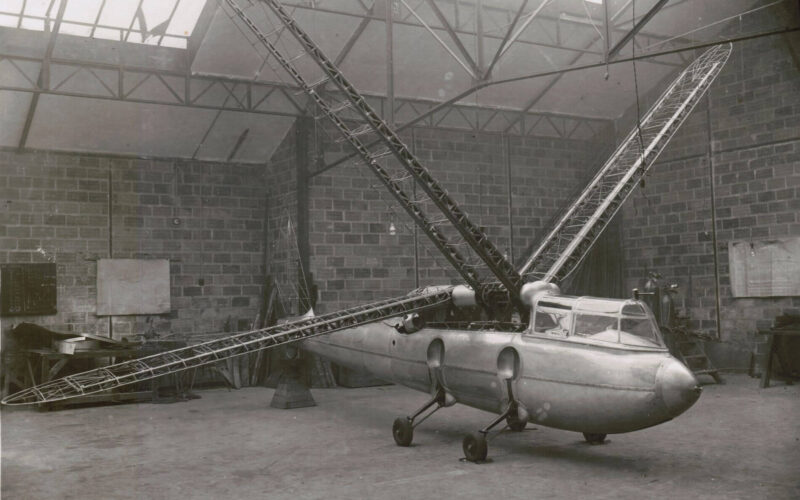A number of iconic images spring to mind when Frank Herbert’s 1965 seminal sci-fi work, Dune, is mentioned: boundless desert, giant sandworms, and an ornithopter flying above the scene.
This peculiar machine was not invented by Herbert, though. The concept of ornithopters has existed for a while. The word itself comes from Greek ‘ornis’ – meaning ‘bird’ – but not all ornithopters are based on birds. In fact, Herbert himself, while avoiding detailed descriptions, refers to his ornithopters as insectoid.
So, ‘ornithopter’ refers to any aircraft that uses flapping wings to propel itself forward – in contrast to conventional propellers, jets or rockets.
It is customary to credit Leonardo da Vinci as the machine’s inventor, but the idea can be traced back to Greek myth and the tale of Icarus.
Today, this idea seems fairly ridiculous. It conjures an image of early attempts at flight, of choppy footage from the early 1900s showing naïve pioneers taking a dive from a high rock with some feathers attached to their arms.
But is it really as outdated as it looks?
A silly idea
The history of aviation often begins with the Wright Flyer. We tend to forget that it was preceded by hundreds of earlier attempts. At the time, no one could tell for sure how the flying machine of the future was going to look, and mimicking birds was as good a guess as any other.
Read more: Top 10 airplanes before Wright flyer
There were lots of ideas. They included toy bats powered by rubber bands and mechanical birds with steam engines, as well as one with wings powered by gunpowder charges, built by the famous French inventor, Gustave Trouvé. Ornithopters were among the most popular kinds of aircraft to experiment with in the 19th century.
Eventually, these concepts were consigned to the dustbin, giving way to the far superior aircraft in operation today.
A series of failures
Nevertheless, tests did take place in the 1920s and 30s, among them several gliders which utilized man-powered movement of their wings, including designs by Alexander Lippish which flew in 1929 and Boris Cheranovsky which flew in 1937. While demonstrating an arguably better performance than other gliders of the time, they were still unable to fly for an extended period.
There were attempts to mount an engine on some of them. A variety of the most notable internal combustion engine-powered ornithopters were designed by René Louis Riout, who built a whole series of insectoid-like machines between the 1910s and the 1940s.
Those machines may have been an inspiration for designers working on the Dune film. With a distinct dragonfly-like shape, they remain some of the most unusual aircraft ever constructed – even if none of them actually took off.
Massive advancements in engineering and computer science had to be achieved for the idea of the ornithopter to make a comeback and show that perhaps those early attempts had some merit.
The era of drones
Studies of birds’ and insects’ wings continued throughout the 1960s and 70s. A lot of small-scale tests were conducted as scientists tried to understand how flapping wings should be designed.
It transpired that for such a wing to work, it had to display a whole range of specific material properties that earlier engineers had no idea about. It was not enough for a wing to simply flap up and down – it had to bend, turn and pivot in a specific way. Rigid wings built by Riout and others simply had no chance.
By the 1990s there was a solid theoretical base behind the idea, developed in part by modelling the movement of the wings in a virtual environment.
Then, new experiments started popping up one after another. The examples in the link are just a small sample of what became an entire field, with scores of dedicated researchers, conferences, and communities of hardcore enthusiasts bent on restoring the image of their favorite kind of flying machine.
The new research shed light on why the early experiments were unsuccessful, and not just because of problems with the wings.
For one, there is a reason why birds and insects are the size they are. Flapping wings work best at certain scales. In fact, at some sizes, they are superior to other means of propulsion.
One study shows that, in theory, a bird-sized drone with ornithopter wings has the potential to consume one-third less energy than your average quadcopter while flying or hovering. We are still some way away from building these kind of mechanic birds, but not for the lack of trying.
So, it could be argued that ornithopters are the aircraft of the future – just not in the way originally envisaged. The laws of physics means that we are highly unlikely to see a Boeing 737-sized aircraft with flapping wings: they would be terribly inefficient, if not mechanically impossible. However, it may be an option for the fast-growing market of small drones.
But, in a star system far, far away, using jumbo jet-sized ornithopters could make sense.

